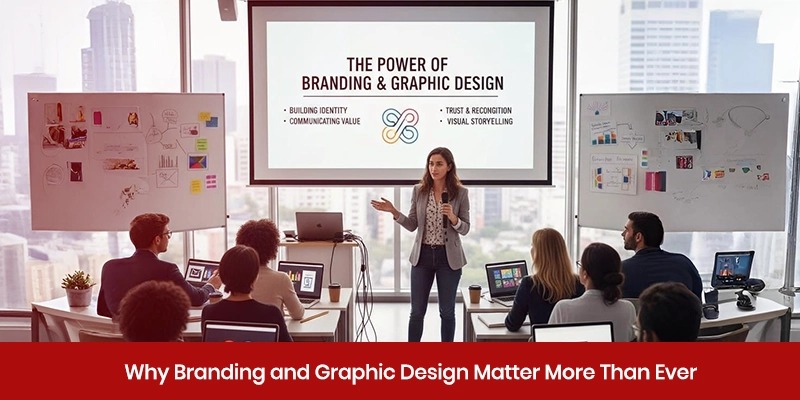
Branding has always been the silent force that drives customer choices, but in 2025 it is no longer silent it is loud, visible, and influential. Every business, from global corporations to local startups, competes for attention in an environment where customers scroll through endless content daily. What makes them stop, notice, and remember? The answer is branding powered by effective graphic design.
Graphic design is not about making things “look good.” It is the core of how businesses communicate visually, establish credibility, and stand apart in a noisy marketplace. Combined with a strong brand identity, design transforms into a strategic weapon for growth and loyalty.
In this blog, we will explore why branding and graphic design matter more than ever, how leading companies leverage them, and what practical lessons businesses can apply today.
The Rise of Visual-First Business Culture
Customers today experience brands visually first. Before they read a single word of copy, they judge the logo, the packaging, the website layout, or even the social media feed. Graphic design shapes that first impression.
Think about Apple. Their minimalist design approach, clean packaging, sleek product visuals, and uncluttered stores aren’t accidental. It communicates precision, innovation, and luxury. Without saying a word, Apple convinces customers that its products are premium. That is graphic design embedded into brand identity.
When a brand ignores design, it sends the opposite signal: lack of professionalism and lack of trust. In a crowded market, poor design is costly.
Branding as the Anchor of Recognition
Branding is more than a logo or a tagline it is the consistent story a business tells across every touchpoint. Strong brand identity builds recognition and trust, two elements every business needs to thrive.
Coca-Cola is a textbook example. For over a century, the brand has used the same red-and-white palette, dynamic script typography, and recognizable bottle shape. Customers don’t just buy a drink; they buy into the feeling of refreshment and happiness Coca-Cola projects. Their graphic design choices are inseparable from their global brand identity.
This recognition is what keeps Coca-Cola ahead of countless competitors in the beverage industry. Branding, supported by graphic design, ensures longevity.
Why Graphic Design Is Business Strategy, Not Decoration
Many businesses still see graphic design as something to “beautify” marketing materials. This view is outdated and harmful. Design is a strategic tool. It communicates values, establishes positioning, and guides customer behavior.
For example, Nike’s branding strategy relies on a simple yet powerful design. The swoosh logo is minimal, but it symbolizes motion, ambition, and victory. Paired with bold typography and emotional visuals of athletes, Nike consistently tells the story of empowerment. The message is not “buy our shoes.” It is “be part of greatness.” Graphic design is the vessel for that message.
When companies neglect design, they leave gaps in their story. Customers notice these inconsistencies, and trust weakens.
The Digital Age: Why Design Matters More Than Ever
The explosion of digital platforms has amplified the importance of visual communication. Customers interact with brands across websites, apps, social media, and online ads. Consistent branding across these platforms is crucial.
A modern website with poor design leads to instant drop-offs. Research shows that users form an opinion about a website in under 50 milliseconds. If the design feels outdated or confusing, customers leave—no matter how strong the product is.
On the flip side, platforms like Instagram and TikTok reward brands that prioritize high-quality visuals. Brands that use graphic design to tell stories visually gain faster traction than those relying only on text-based communication.
Take Airbnb as an example. Their brand identity combines friendly typography, playful color palettes, and human-centered imagery. The design communicates trust and inclusivity, which is critical for convincing people to stay in homes of strangers. Without thoughtful design, their business model would struggle.
Key Elements of Strong Branding and Graphic Design
To understand why branding and graphic design matter, it’s helpful to break down their essential components. These are the areas where brands must invest:
1. Logo Design
A logo is the cornerstone of visual identity. It must be simple, memorable, and scalable. Starbucks evolved its mermaid logo over the decades, but it never lost the essence of what the brand represents.
2. Typography
Typography shapes tone and personality. Google’s use of clean, rounded fonts reflects its mission of accessibility and simplicity. Typography is not decoration; it conveys emotion and intent.
3. Color Palette
Colors trigger emotions. Blue suggests trust and professionalism (used by brands like IBM and Facebook), while red conveys excitement and urgency. Choosing and sticking to a color palette makes brands recognizable in seconds.
4. Visual Consistency
Every design element, from social media posts to business cards, should reflect a unified identity. Inconsistency confuses customers. Consistency builds memory.
5. Storytelling Through Design
Great brands use design to tell stories. Disney’s branding relies on whimsical typography, castle imagery, and magical color schemes all reinforcing the story of imagination and childhood wonder.
How Big Brands Master Branding Through Design
Let’s look at real-world lessons from global giants:
Apple: Minimalist packaging and product design show innovation and premium quality. Customers feel they are buying not just a device but a lifestyle.
Coca-Cola: Consistent use of red, typography, and bottle shape has built an emotional connection for decades. The design makes their products instantly recognizable worldwide.
Nike: The swoosh plus powerful visuals of athletes represent empowerment. The design supports their core message: “Just Do It.”
Airbnb: Inclusive color palettes and friendly visuals build trust and belonging. The design supports their mission of community and exploration.
McDonald’s: Golden arches are one of the most recognizable brand symbols globally. Paired with red and yellow, the design communicates speed, affordability, and happiness.
Each of these examples shows how graphic design strengthens brand identity and supports business growth.
Small Businesses: Why Design Is Even More Critical
For startups and small businesses, design is often treated as optional due to budget constraints. But in reality, it is more critical at this stage. Unlike big brands with established reputations, small businesses rely on first impressions to gain trust.
A poorly designed logo or website can instantly turn away potential customers. On the other hand, a polished and consistent design gives credibility and levels the playing field.
Consider a local coffee shop. If the shop invests in branding unique logo, consistent colors, engaging packaging, and an inviting social media presence, it can compete with larger chains. Graphic design gives them the voice to stand out.
Why Branding and Graphic Design Build Trust
Trust is the currency of modern business. People are skeptical and cautious about where they spend their money. Branding and design help bridge that gap.
Professional design signals professionalism. Consistent branding signals reliability. Together, they reassure customers that they are making the right choice.
For example, Tesla’s branding combines futuristic visuals, minimalist typography, and sleek product designs. This communicates innovation and forward-thinking, which builds trust with customers who invest in expensive electric cars.
The Future of Branding and Graphic Design
As technology evolves, branding and graphic design will continue to grow in importance. Trends like AI-generated visuals, interactive branding, and immersive design experiences are shaping the future.
However, one principle will remain constant: businesses that prioritize branding and design will thrive. Those who ignore them will struggle to be remembered.
Practical Takeaways for Businesses
Invest in a professional logo: Avoid cheap templates. Your logo is the foundation of your brand identity.
Stay consistent: Use the same fonts, colors, and style across all platforms. Consistency builds recognition.
Prioritize your website design: Customers judge your business in seconds based on your site’s look.
Leverage social media visuals: Create designs that reflect your brand story across platforms.
Think long-term: Branding is not a one-time project. It is an ongoing commitment to telling a cohesive story.
Conclusion: Branding and Design Are Business Essentials
Branding and graphic design are not optional extras anymore. They are essential for standing out, building trust, and growing in a saturated marketplace. Whether you are Apple shaping a lifestyle, Coca-Cola creating timeless recognition, or a local startup fighting for attention, your design choices define how the world sees you.
Graphic design brings brand identity to life. Together, they form the backbone of recognition, loyalty, and growth. In 2025 and beyond, businesses that understand this truth will be the ones customers remember.





